
Reinforced concrete (RC), also called reinforced cement concrete (RCC), is a composite material in which concrete's relatively low tensile strength and ductility are counteracted by the inclusion of reinforcement having higher tensile strength or ductility. The reinforcement is usually, though not necessarily, steel reinforcing bars (rebar) and is usually embedded passively in the concrete before the concrete sets.

The Salk Institute for Biological Studies is a scientific research institute located in the La Jolla community of San Diego, California on the Pacific coast. The independent, non-profit institute was founded in 1960 by Jonas Salk, the developer of the polio vaccine; among the founding consultants were Jacob Bronowski and Francis Crick. Construction of the research facilities began in spring of 1962. The Salk Institute consistently ranks among the top institutions in the US in terms of research output and quality in the life sciences. In 2004, the Times Higher Education Supplement ranked Salk as the world's top biomedicine research institute, and in 2009 it was ranked number one globally by ScienceWatch in the neuroscience and behavior areas.

Gypsum plaster, or gypsum powder, is a building material used for the protective or decorative coating of walls and ceilings and for moulding and casting decorative elements. In English "plaster"/Powder usually means a material used for the interiors of buildings, while "render" commonly refers to external applications. Another imprecise term used for the material is stucco, which is also often used for plasterwork that is worked in some way to produce relief decoration, rather than flat surfaces.

A basement or cellar is one or more floors of a building that are completely or partly below the ground floor. It generally is used as a utility space for a building, where such items as the boiler, water heater, breaker panel or fuse box, car park, and air-conditioning system are located; so also are amenities such as the electrical distribution system and cable television distribution point. In cities with high property prices, such as London, basements are often fitted out to a high standard and used as living space.

Stucco or render is a construction material made of aggregates, a binder, and water. Stucco is applied wet and hardens to a very dense solid. It is used as a decorative coating for walls and ceilings, external building siding, and as a sculptural and artistic material in architecture. Stucco may be used to cover less visually appealing construction materials, such as metal, concrete, cinder block, or clay brick and adobe.
This page is a list of construction topics.

Waterproofing is the process of making an object or structure waterproof or water-resistant so that it remains relatively unaffected by water or resisting the ingress of water under specified conditions. Such items may be used in wet environments or underwater to specified depths.

A vapor barrier is any material used for damp proofing, typically a plastic or foil sheet, that resists diffusion of moisture through the wall, floor, ceiling, or roof assemblies of buildings to prevent interstitial condensation and of packaging. Technically, many of these materials are only vapor retarders as they have varying degrees of permeability.
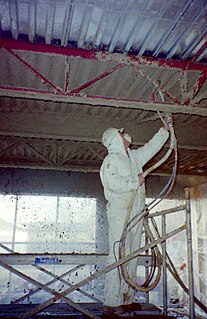
Fireproofing is rendering something resistant to fire, or incombustible; or material for use in making anything fire-proof. It is a passive fire protection measure. "Fireproof" or "fireproofing" can be used as a noun, verb or adjective; it may be hyphenated ("fire-proof").

Structural dampness is the presence of unwanted moisture in the structure of a building, either the result of intrusion from outside or condensation from within the structure. A high proportion of damp problems in buildings are caused by ambient climate dependent factors of condensation and rain penetration. Capillary penetration of fluid from the ground up through concrete or masonry is known as "rising damp" and is governed by the shape and porosity of the construction materials through which this evaporation limited capillary penetration takes place. Structural damp, regardless of the mechanisms through which it takes place, is exacerbated by higher levels of humidity.

Damp proofing or a Damp-Proof in construction is a type of moisture control applied to building walls and floors to prevent moisture from passing into the interior spaces. Dampness problems are among the most frequent problems encountered in residences.
Basement waterproofing involves techniques and materials used to prevent water from penetrating the basement of a house or a building. Waterproofing a basement that is below ground level can require the application of sealant materials, the installation of drains and sump pumps, and more.

Albert Kahn Associates is an architectural design firm in Detroit, Michigan with a second office located in Miami, Florida. It was established in 1895 and is still active. Recent work includes being awarded third place in the Virtual Modeling Stage of NASA’s 3D-Printed Habitat Competition for their work on martian habitats, and also creating the world's largest penguin conservation center, Polk Penguin Conservation Center. In earlier years, it introduced a new technology in industrial building involving a unique reinforced concrete method referred to as the Kahn System of construction using proprietary patented reinforcement steel manufactured by Trussed Concrete Steel Company. The building of automobile factories and other types of factories were revolutionized from wooden timber framing construction. Besides being an advanced technology in strength that led to wider open interior spaces, it featured a high degree of fire resistance and larger window space for light. The firm started by Albert Kahn built factories for Chrysler for over a decade, Ford Automobile for 30 years and Packard Automobile for 35 years. Other important clients of the firm were Republic Steel and General Motors. The firm was awarded a $40 million contract to build a tractor factory in Russia in 1928. The firm's output was over a million dollars worth of work per week by 1929. By 1939, the firm designed 19 percent of all industrial buildings in the United States and had designed some $800 million of buildings worldwide.
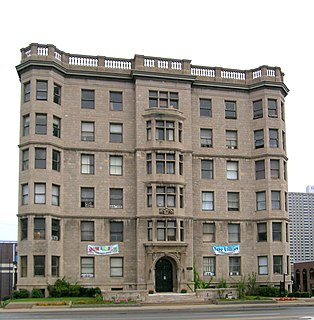
The Palms is an apartment building located at 1001 East Jefferson Avenue in Detroit, Michigan. It was one of the first buildings in the United States to use reinforced concrete as one of its major construction materials. It was listed on the National Register of Historic Places in 1985.
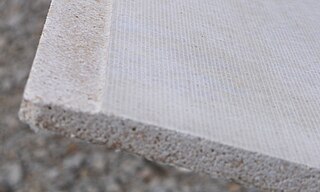
Magnesium oxide, more commonly called magnesia, is a versatile mineral that when used as part of a cement mixture and cast into thin cement panels under proper curing procedures and practices can be used in residential and commercial building construction. Some versions are suitable for a wide range of general building uses and for applications that require fire resistance, mold and mildew control, as well as sound control applications and many other benefits. As an environmentally friendly building material, magnesia board has strength and resistance due to very strong bonds between magnesium and oxygen atoms that form magnesium oxide crystals.

The Packard Automotive Plant is a former automobile-manufacturing factory in Detroit, Michigan, where luxury cars were made by the Packard Motor Car Company and later by the Studebaker-Packard Corporation.

Julius Kahn was an American engineer, industrialist, and manufacturer. He was the inventor of the Kahn System, a reinforced concrete engineering technique for building construction. The Kahn System, which he patented in 1903, was used worldwide for housing, factories, office and industrial buildings.

The Trussed Concrete Steel Company was a company founded by Julius Kahn, an engineer and inventor. The company manufactured prefabricated products for reinforced concrete beams and steel forms for building reinforced concrete floors and walls. Kahn invented and patented a unique new technology reinforcement system of construction called the Kahn System that was stronger, more economical, and lighter than the existing old school technology used up to that point to construct buildings. The old method was to use plain straight smooth steel beams or loose rods or stirrups in concrete beams and floors. Kahn's new technology improved system used 45 degree tab flanges or "wings" permanently attached on steel beams that distributed the tension stress for overall improvement in strength of reinforced concrete.
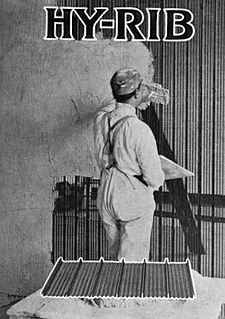
Hy-Rib was a brand name for a product manufactured by the Trussed Concrete Steel Company. It is an engineering reinforcement system for floors, walls, and ceilings of buildings and houses. This product is a derivative of the Kahn Trussed Bar for beams and columns that was invented by Julius Kahn. Kahn engineered the Hy-Rib products and they were first manufactured in 1909.
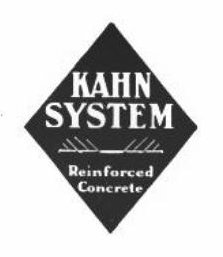
The Kahn system is an industrial construction technique for reinforcement of buildings that was engineered and patented by Julius Kahn. The Kahn system is an industrial construction design using the Kahn Trussed Bar as the bases. This steel bar was a new type of reinforcing bar used in concrete and had unique engineered features to distribute stress.























